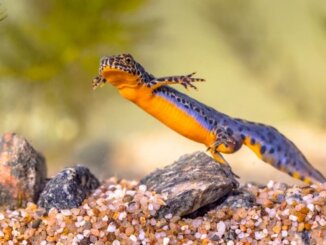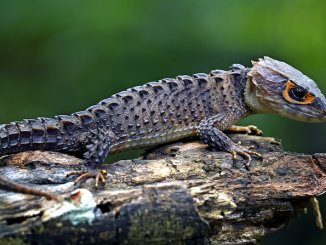These remarkable creatures are not your typical pet lizards, as they are uncommon in the pet trade. Because they are challenging to raise, we recommend them only to the experienced reptile keeper.
Philippine flying dragons are common in the Philippines region’s coastal coconut tree plantations and abundant in the Northern Philippines trees. These lizards are known for their ability to glide from trees using the skin flaps on their sides.
If you want to own one of these unique creatures, learning how to care for them appropriately is crucial, so keep reading to learn more.
Quick Facts
| Common name | Flying dragon, Draco lizard |
| Scientific name | Draco spilopterus |
| Adult size | 8-12 inches long, 26 grams |
| Lifespan | 8-10 years |
| Diet | Insects |
| Tank size | 80-85℉ daytime, 70-75℉ nighttime, 90-95℉ basking area, ≥75% humidity |
| Popular alternatives | Flying gecko, basilisk, false Malabar gliding frog |
What Is a Philippine Flying Dragon?
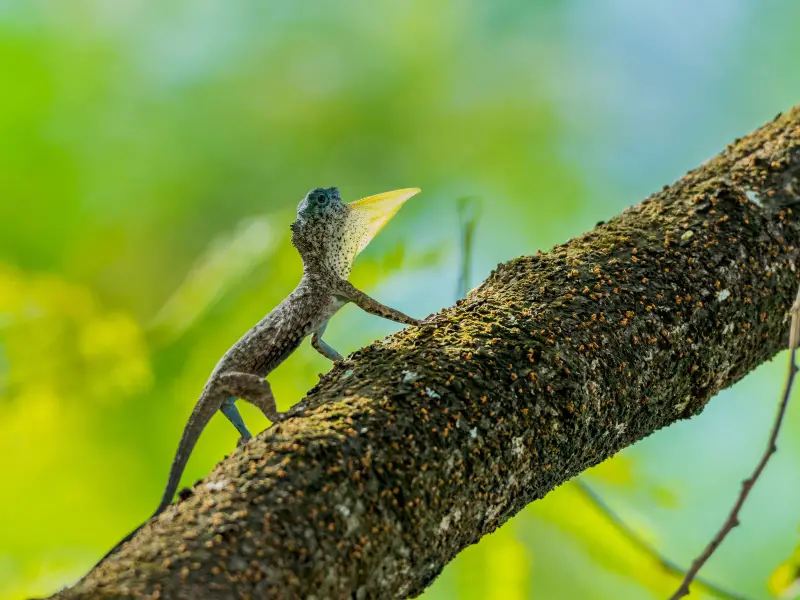
The Philippines is home to this unique arboreal flying lizard. These lizards dwell in mango tree trunks, coconut plantations, and dense to lower density and undisturbed forest branches. If you ever get a chance to see one up close, you’ll notice they grow to about 8-12 inches long, including their tail.
These lizards have membranes on their throats, called dewlaps, and on the sides of their bodies, referred to as their wings (or patagium). These membranes fan out to help the lizards glide from tree to tree, which is how they earned the name “flying dragon.”
Classification
These creatures belong to the genus Draco, which includes all 41 species of flying dragons. The “common flying dragon,” scientifically known as Draco volans linnaeus, was the first species observed in 1758, with the remaining 40 species labeled as direct children of the genus.
One of the more elusive species of the flying dragon is the Philippines flying dragon, classified as Draco spilopterus. This species was first documented in 1834 and is rare to acquire, adding to its allure among collectors.
Here are a few reasons why owning a Philippine flying dragon may be an exciting choice among reptile enthusiasts:
- Watching a flying dragon take flight and easily glide through the air is a breathtaking experience.
- Their behavior is another aspect that makes them fascinating creatures to study and keep as pets.
- Their uniqueness, vibrant colors, and striking markings make them a visually appealing addition to any collection.
The term “Draco” comes from Latin and means “dragon.” A highly fitting name, given this lizard’s appearance and abilities!
Philippine Flying Dragon Care Sheet
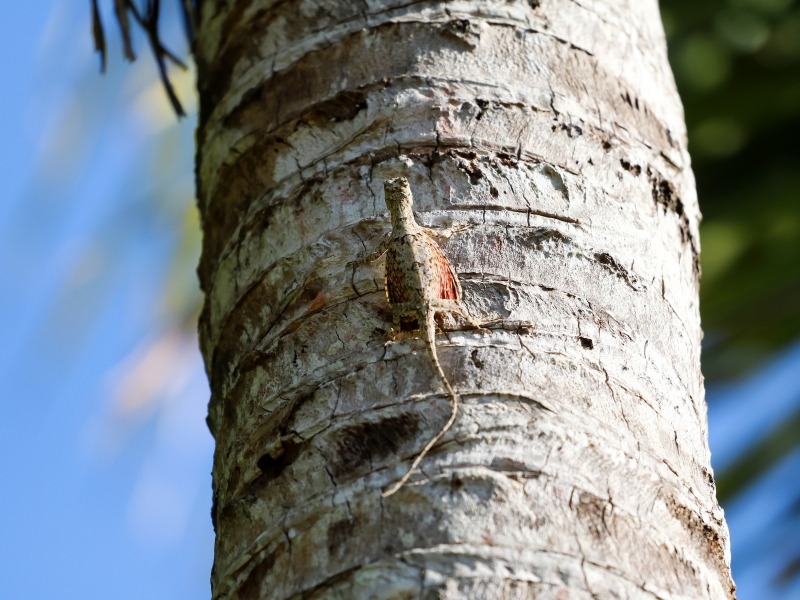
This care guide serves as a starting point for Philippine flying dragon husbandry. It’s essential to consider various factors to ensure the health and happiness of the specific species. As such, conduct additional observations and interventions daily.
Care requirements include the following:
- UVB lamps and fluorescent or LED plant lamps.
- A mixed diet of insects, mainly ants.
- An unnatural but conventional and adequate diet includes flyers, mealworms, and crickets.
- Additional vitamin supplements.
- It requires a tall and broad enclosure with many branches and leaves.
Tank and Enclosure
The tank can be glass or screened with extra misting. It should measure more than two feet deep, two feet wide, and two feet high; that’s the absolute minimum for low-space scenarios. We recommend choosing the largest size possible for these fascinating yet delicate lizards.
In addition, there should be soft and compactable ground for females to lay eggs and many branches and leaves to replicate their natural environment better.
Lighting and Heating
Philippine flying dragons prefer to be active during the day, requiring 12 hours of daylight maximum, preferring the early mornings and late afternoons.
They need a well-lit UVB enclosure with hiding places to thrive. A UV radiometer can monitor UVB bulbs for replacement. We recommend additional fluorescent or LED bulbs for plant growth and the basking area.
Reptile habitats benefit from increased UVB output, which can prevent or reverse metabolic bone disease commonly seen in captive reptiles.
Basking and “cool” sides should be in the tank, each with different temperatures. Use two thermometers to monitor and regulate.
- Philippine flying dragons enjoy basking in the heat. The basking area should be between 90℉-95℉.
- The rest of the tank should be around 80-85℉ during the day, decreasing by 10 degrees at night.
An unrestful Philippine Flying Dragon that doesn’t engage in periods of inactivity for 1-3 hours may require better conditions. In the wild, the lizard usually rests from 11 a.m. to 1 p.m. when temperatures are higher.
In general, temperatures and humidity should be relatively high. The moisture in the tank should stay narrowly greater than or equal to 75%, which can be achieved by misting the tank continually throughout the day.
Substrate
We recommend using soft and compactable dirt. Males are better off with a fiber moss substrate since they seldom come into contact with the ground, making it easier to clean and dispose of waste.
However, a bioactive substrate is necessary for female reptiles, especially for successful breeding. This substrate should be a mixture of leaves, bark, and coconut coir and regularly cleaned or replaced once bacterial growth is detected.
What Does a Philippine Flying Dragon Eat?
These creatures are stealthy and aggressive insectivorous hunters, attacking their prey when it’s nearby. While ants should make up most of their food (50-99%), captive-bred dragons can also be fed other protein-rich insects such as mealworms, waxworms, flies, or plump crickets as a supplement or primary source.
In the wild, flying dragons eat ants, leaf beetles, ladybugs, millipedes, caterpillars, moth larvae, and termites.
Feeding ants daily to wild-caught juvenile dragons is essential to help them acclimate to captivity. Later, incorporate a mixed diet by providing smaller insects every other day and monitoring their preferences. It’s best to include calcium and vitamin supplements several times a week.
How to Keep Them Healthy
Inexperienced keepers may struggle with keeping captive-bred babies alive, and wild-caught specimens often arrive in poor condition and have difficulty acclimating. Indeed, these species require constant monitoring to ensure they eat, drink, and adjust.
In addition, these delicate creatures are prone to dehydration, making it essential to provide them with a suitably moist habitat. Unless you plan to purchase a large group of them to breed in captivity, beginners shouldn’t take on the challenge.
Cleaning Their Tank
Replace the primary fiber and bio mix substrates every week or two and any other substrates requiring attention. And conduct spot cleaning daily to remove old food, feces, or dirty water.
How Long Do Philippine Flying Dragons Live?
In the wild, healthy adults reach 8-10 years. However, in captivity, that number can decrease depending on the keeper’s experience level. Knowing what an unhealthy flying dragon looks like can help you catch and treat any illnesses before they overwhelm your lizard friend.
A healthy Philippine flying dragon is calm when resting, has normal eating and drinking habits, moves around between different areas of its tank, and is reactive to being handled.
Conversely, if your dragon is sick, it may appear agitated, refuse to eat or drink water, and be randomly active at night.
Behavior
The species is territorial in its natural habitat, typically residing in 2-3 trees, and males interested in the same area become aggressive. The dominant lizard usually drives away the loser and accepts an additional one or two females in the area.
When feeling threatened, they extend their dewlap to appear intimidating and use their patagium to appear bigger while bobbing their body up and down.
Never house males together, as doing so leads to fatal injuries.
Handling
Before and after handling your Philippine Flying Dragon, wash your hands to prevent the spread of harmful bacteria. Be forewarned that they are not fond of being handled by humans. When grabbed, they typically lash out and attempt to bite you with their tiny fangs.
Appearance
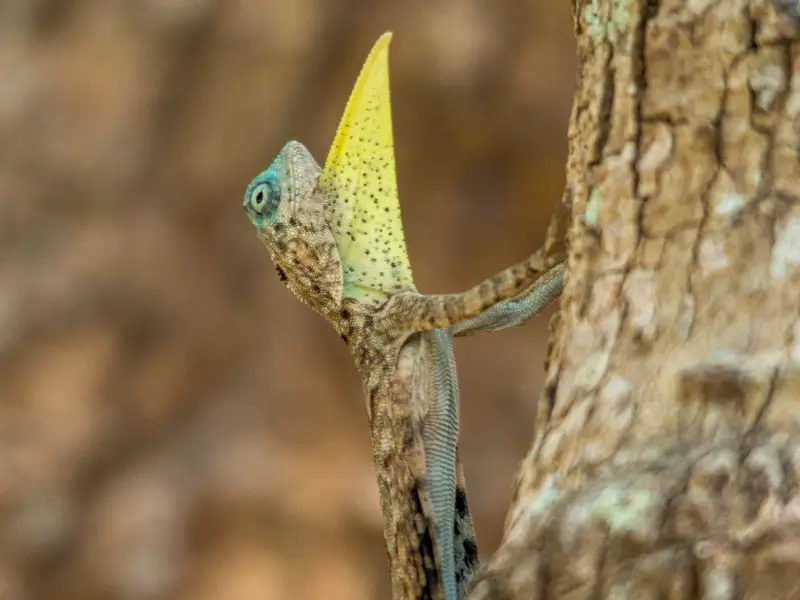
They have a distinct pattern covering their entire patagium. Their heads are slim, narrow, and triangular. The dewlap is shorter on females. Furthermore, the sides of their neck stretch horizontally to form a pair of smaller “wings” around their head, called throat lappets.
They also have a wattle in their neck that helps release excess heat.
Size
An adult Philippine flying dragon is between 8 to 12 inches long. It will be around 25.58 g and should reach this weight within 24 months.
Colors
The following are distinctive features of the Philippine flying dragon:
- The dewlap varies from green to a yellow or whitish-blue hue.
- Brown or green body.
- The wing base is orange-yellow.
- Uniformly dispersed black spots on the wing.
- A dark patch at the wingtip (thoracic ribs).
- In some cases, the wings may lack their base hue.
Philippine Flying Dragon Babies
Philippine flying dragons tend to shy away when being watched. However, when a male is interested in courting a female, he will often circle her and fan out his membranes, subtly or in a relaxed manner, to impress her.
In the wild, these creatures mate between December and January. Then, the female digs a small hole in the ground with her head to create a nest where she lays her eggs. Typically, a clutch contains about five eggs, which the female covers back up with soil using her head.
The female flying dragon will guard her nest for about 24 hours before abandoning it. After that, the eggs will need around 32 days to incubate.
How Much Does a Philippine Flying Dragon Cost?
If you manage to track one down, expect to pay a premium for the Philippine flying dragon species. On the other hand, the common flying dragon (Draco volans) goes for around $40-65 for babies and $200 for adults.
Care Guide Summary
These lizards are sought after for their distinct dragon aesthetic, making them a favorite among fantasy lovers. However, while Philippine flying dragons are calm when kept undisturbed in captivity, they are unique reptiles requiring experienced handlers due to their delicate nature.
They have specific heating, moisture, and lighting conditions and thrive on an insect diet. The flying gecko may be more suitable for those new to reptile ownership.
If you’re lucky enough to bring a Philippine Flying Dragon to your home, it’s essential to care for it like a baby.

